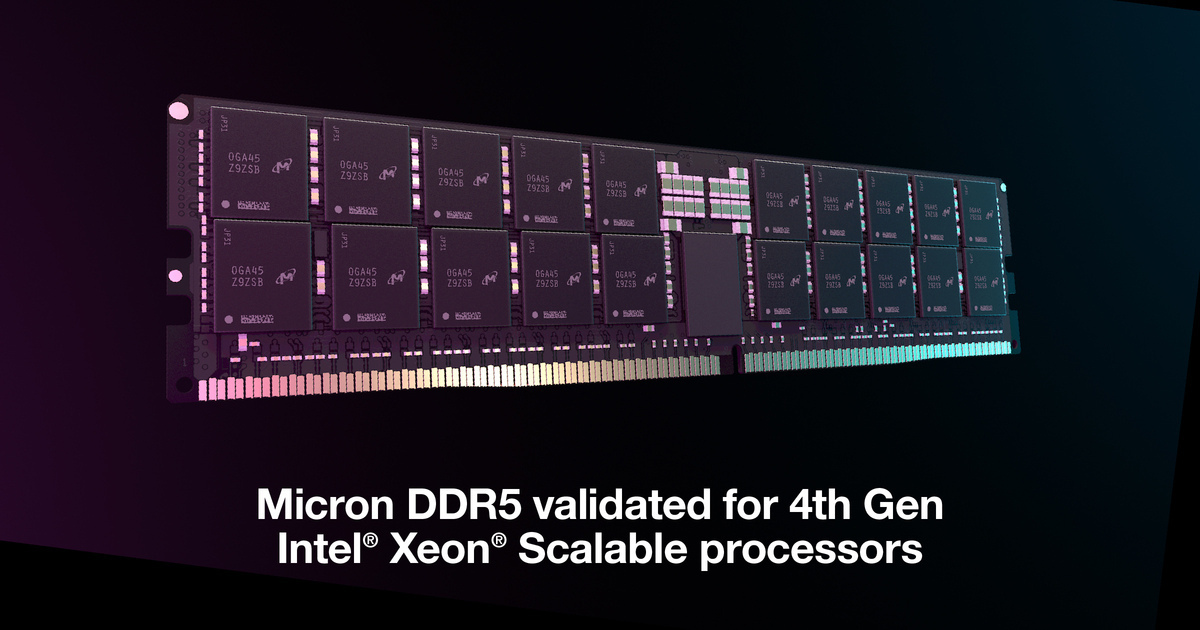Micron Technology, Inc. announced that its DDR5 server memory portfolio for the data center is now fully validated on the 4th Gen Intel Xeon Scalable processor family. Micron DDR5 memory delivers up to twice the memory bandwidth over previous generations, which is essential to fueling the rapid growth of cores in today’s data center processors. Transitioning to DDR5 will help alleviate a potential bottleneck for years to come by providing higher bandwidth to unlock more computer power per processor. Micron DDR5, in combination with 4th Gen Intel Xeon Scalable processors, benefits a wide range of workloads including SPECjbb, which delivers up to 49% performance improvement on benchmarking for Critical-jOPS (Java operations per second) compared to previous generations.[1] In addition to increased memory bandwidth and performance, Micron DDR5 memory is also designed to improve reliability across the data center with features such as on-die Error Correction Code (ODECC) and bounded faults. On-die ECC corrects single-bit errors and detects multi-bit errors.
[1] SPECjbb is a benchmark used to measure performance and scalability of Java-based web applications. Critical-jOPS results signify transactional throughput with guaranteed response times.
““The deep collaboration we have established with Intel as a highly valued ecosystem partner, has allowed Micron to remain at the forefront of the industry transition to DDR5,”
“This work has been pivotal in developing solutions that meet the complex needs and challenges of our data center customers as they convert massive amounts of data into insights.”
Raj Hazra – Senior Vice President and General Manager of Micron’s Compute and Networking Business Unit
“The 4th Gen Intel® Xeon® Scalable processor (codenamed Sapphire Rapids) represents a big generational leap in performance across a vast array of workloads, from fast-growing artificial intelligence, analytics and networking to storage and mission-critical workloads,”
”The 4th Gen Intel Xeon Scalable processors support a wide breadth of memory solutions across the industry. Micron’s fully validated DDR5 server memory forms a key part of Intel’s comprehensive validation matrix which provides data center customers reliability, performance scalability and increased infrastructure flexibility and configurability.”
Dr. Dimitrios Ziakas – Vice President of Intel’s Memory and IO Technologies
Working closely with Lenovo, Micron DDR5 and 4th Gen Intel Xeon 8480H Platinum processors deliver 43% more transactions for SAP workloads[2] compared with Micron DDR4 and 3rd Gen Intel Xeon 8380 Platinum processors.
[2] 250,470 SAPS with Dual Socket Lenovo SR650 V2 with 3rd Gen Intel Xeon Platinum 8380 processor with Micron DDR4 3200 MHz system is capable of 410 GB/sec, compared to 356,980 SAP with Dual Socket Lenovo SR650 V3 with 4th Gen Intel Xeon Platinum 8490H processor with Micron DDR5 4800 MHz system is capable of 573 GB/sec.
“With the growth of predictive analytics, customers across every major industry are demanding memory solutions that maximize effective bandwidth and enable complex workloads from edge to cloud. Our collective efforts with Micron throughout the development and validation phase, with these performance-intensive workloads in mind, allow us to deliver ThinkSystem V3 servers with a new era in memory performance accelerated by DDR5,”
Kamran Amini – Vice President and General Manager of Server & Storage, Lenovo Infrastructure Solutions Group
Micron has played a pivotal role in JEDEC’s creation of a DDR5 memory specification. The Micron Technology Enablement Program (TEP), the first of its kind in the industry, gave system designers early access to the key internal resources and samples to assist their DDR5 validation process, and it remains available to aid in customer qualifications. Micron is committed to partnering across the ecosystem and will continue to invest in its leadership technology and product roadmaps.




